Tuesday, March 8, 2022
class-9 Subject English Grammar Essay On Importance of Education
Friday, February 18, 2022
CLASS- 9 SUBJECT : SOCIAL STUDEIS CHAPTER-9 POVERTY AS A CHALLENGE
EVENTS CONVENT HIGH SCHOOL
25/02/2022 CLASS- 9 SESSION 2021-22
SUBJECT : SOCIAL STUDEIS
CHAPTER-9
POVERTY AS A CHALLENGE
____________________________________
Very Short Answer Type Questions
Question 1.
When the health of a person suffers due to deficiency of nutrients in food as per his daily requirement, he/she is said to be the victim of _______ .
Answer:
Malnutrition
Question 2.
What helped West Bengal in reducing poverty?
Answer:
Land reform measures.
Question 3.
How many people in India live below the poverty line?
Answer:
270 million.
Question 4.
In rural areas in India, the accepted average calories requirement per person per day is _______ .
Answer:
2400 calories.
Question 5.
What is the most difficult challenge faced by independent India?
Answer:
Poverty
Question 6.
PMRY was started in 1993, stands for _______ .
Answer:
Prime Minister Rojgar Yozana
Question 7.
SGSY was launched in 1999 for assisted poor families above poverty line by organising them into self-help groups.
Answer:
Swarnajayanti Gram Swarozgar Yojana
Question 8.
PMGY was launched in 2000 to provide rural shelter, rural drinking water, primary health, primary education and rural electrification. It stands for _______ .
Answer:
Pradhan Mantri Gramodaya Yozana
Question 9.
What is poverty?
Answer:
Poverty is a situation in which a person is unable to satisfy minimum basic necessities of life, i.e., food, clothing, education, shelter, health, etc.
Question 10.
What are the two methods of estimating the poverty line.
Answer:
There are two methods of measuring poverty line—
- Level consumption expenditure method and
- Income method.
Short Answer Type Questions
Question 1.
What are the indicators used by social scientists to understand poverty?
Answer:
The indicators used by social scientists to understand poverty are :
- Levels of income and consumption
- Lack of general resistance due to malnutrition
- Lack of access to healthcare
- Lack of job opportunities
- Lack of access to safe drinking water, sanitation, etc.
Question 3.
Explain how the low level of education of the poor people can be held responsible for poverty in India.
Answer:
- Low level of education of the poor is a major cause behind their poverty. Poor people do not have access to education.
- Because of illiteracy, the Indian farmers have failed to learn new methods of cultivation. Even the village moneylenders succeed in cheating them quite easily.
- Moreover, poor parents are not able to send their children to schools. So, the poor people are employed as unskilled workers and are paid low wages due to low level of education.
Question 3.
Explain the principle measures taken in Punjab, Kerala and Andhra Pradesh to reduce poverty.
Answer:
The measure taken in Punjab, Kerala and Andhra Pradesh to reduce poverty are :
- The principal measures taken in Punjab to reduce poverty is increasing the agricultural growth rates.
- Kerala has focused more on human resource development to reduce poverty.
- Andhra Pradesh focused on public distribution of food grains to reduce poverty.
Question 4.
What does social exclusion mean?
Answer:
- According to this concept, poverty must be seen in terms of the poor having to live only in poor surrounding with other people, excluded from enjoying social equality of better-off people in better surroundings.
- Social exclusion can be both a cause as well as a consequence of poverty in the usual sense.
- Broadly, it is a through in which individuals or groups are excluded from facilities, benefits and opportunities that others enjoy.
Saturday, February 12, 2022
CLASS-9 SUBJECT SOCIAL SCIENCE CIVIC CHAPTER-5 WORKING OF INSTITUTION
EVENTS CONVENT HIGH SCHOOL
12/02/2022 CLASS- 9 SESSION 2021-22
SUBJECT : SOCIAL SCIENCE CIVIC
CHAPTER-5
WORKING OF INSTITUTION
______________________________________
1. TICK THE CORRECT OPTION :-
Question-1
If you are elected as the president of India which of the following decision can you take on your own?
(a) Select the person you like as Prime Minister.
(b) Dismiss a Prime Minister who has a majority in Lok Sabha.
(c) Ask for reconsideration of a bill passed by both the Houses.
(d) Nominate the leaders of your choice to the Council of Ministers.
Solution:
(c) Ask for reconsideration of a bill passed by both the Houses.
Question-2
Who among the following is a part of the political executive ?
(a) District Collector
(b) Secretary of the Ministry of Home Affairs.
(c) Home Minister
(d) Director General of Police
Solution:
(c) Home Minister.
Question-3
Which of the following statements about the judiciary is false ?
(a) Every law passed by the parliament needs approval of the Supreme Court.
(b) Judiciary can strike down a law if it goes against the spirit of the Constitution.
(c) Judiciary is independent of the Executive.
(d) Any citizen can approach the courts if her rights are violated.
Solution:
(a) Every law passed by the Parliament needs approval of the Supreme Court.
Question-4
Which of the following institutions can make changes to an existing law of the country?
(a) The Supreme Court
(b) The President
(c) The Prime Minister
(d) The Parliament
Solution:
(d) The Parliament
Match the ministry with the news that the ministry may have released.
| (a) A new policy is being made to increase the jute exports from the country. | (i) Ministry of Defence |
| (b) Telephone services will be made more accessible to rural areas. | (ii) Ministry of Agriculture, Food and Public Distribution |
| (c) The price of rice and wheat sold under the Public Distribution System will go down. | (iii) Ministry of Health |
| (d) A pulse polio campaign will be launched. | (iv) Ministry of Commerce and Industry |
| (e) The allowances of the soldiers posted on high altitudes will be increased. | (v) Ministry of Communications and Information Technology. |
Solution:
| (a) A new policy is being made to increase the jute exports from the country. | (iv) Ministry of Commerce and Industry |
| (b) Telephone services will be made more accessible to rural areas. | (v) Ministry of Communications and Information Technology |
| (c) The price of rice and wheat sold under the public distribution system will go down. | (ii) Ministry of Agriculture, Food and Public Distribution |
| (d) A pulse polio campaign will be launched | (iii) Ministry of Health |
| (e) The allowances of soldiers posted on high altitudes will be increased | (i) Ministry of Defence |
Very Short Answer Type Questions
Question 1.Name the three organs of the Government.
Answer:
- Executive
- Legislative
- Judiciary
Question 2.Who is the head of the state and the head of the government?
Answer:
The President is the head of the state whereas Prime Minister is the head of the government.
Question 3.What is a Parliament? Name the two houses of the Parliament.
Answer:
It is the supreme law making body of India. It has two Houses :
- Lok Sabha
- Rajya Sabha.
Question 4.What are institutions?
Answer:
The arrangements which are made in modern democracies to run the government.
Question 5.Name any three institutions responsible to run the democratic government in India.
Answer:
- The Prime Minister and the Cabinet.
- The Civil Servant.
- The Supreme Court.
Question 6.Name the institution where disputes between citizens and the government are finally settled.
Answer:
The Supreme Court.
Question 7.Why democratic governments insist on institutions? Give two reasons.
Answer:
- Institutions involve rules and regulations.
- Institutions bind the hands of the rulers as these involve meetings, committees and routines.
Short Answer Type Questions
Question-1 Why is the Prime Minister in India not directly elected by the people? Choose the most appropriate answer and give reasons for your choice.
(a) In a parliamentary democracy only the leader of the majority party in the Lok Sabha can become the Prime Minister.
(b) Lok Sabha can remove the Prime Minister and the Council of Minister even before the expiry of their term.
(c) Since the Prime Minister in appointed by the president there is no need for it.
(d) Direct election of the Prime Minister will involve a lot of expenditure on the election.
Solution:
The most appropriate answer is (a).
This is because, in India, only the leader of the majority party/parties in the Lok Sabha can become the Prime Minister. Moreover, if the directly elected Prime Minister who does not have the support of the majority is appointed as the Prime Minister, there are chances that policies or laws suggested by him would not be passed in the Lok Sabha. This would lead to the government being run ineffectively.
Question-2 Three friends went to watch a film that showed the hero becoming Chief Minister for a day and making big changes in the state. Imran said this is what the country needs. Rizwan said this kind of a personal rule without institutions is dangerous. Shankar said all this is a fantasy. No minister can do anything in one day. What would be your reaction to such a film?
Solution:
I would choose to have a majority in the Lok Sabha, as the Lok Sabha is more powerful than the Rajya Sabha because:
- If any law is not passed by both the houses, the final decision is taken in the joint session in which members of both the houses sit together but because of the larger number of members, the view of the Lok Sabha is likely to prevail.
- The Lok Sabha exercises more powers in money matters too. Once the Lok Sabha passes the budget of the government or any other money-related law, the Rajya Sabha cannot reject it.
- Most importantly, the Lok Sabha controls the Council of Ministers. If the majority of the Lok Sabha members say they have no confidence in the Council of Ministers, it has to quit, whereas the Rajya Sabha does not have this power.
Question3 A teacher was making preparations for a mock parliament. She called two students to act as leaders of two political parties. She gave them an option: Each one could choose to have a majority either in the mock Lok Sabha or in the mock Rajya Sabha. If this choice was given to you, which one would you choose and why?
Solution:
I would choose to have a majority in the mock Lok Sabha. This is because of the following reasons:
- The leader of the Lok Sabha is directly answerable to the public, as they are directly elected by them.
- Any ordinary law needs to be passed by both the houses. However, in an undecided situation, the decision of Lok Sabha always prevails due to more members.
- Lok Sabha exercises more power in cases related to money bills as they originate here.
- The Council of Ministers is controlled by the Lok Sabha.
- Lok Sabha has more powers compared to the Rajya Sabha.
Tuesday, February 8, 2022
CLASS-9 SUBJECT ENGLISH CHAPTER-10 THE ACCIDENTAL TOURIST
EVENTS CONVENT HIGH SCHOOL
08/02/2022 CLASS- 9 SESSION 2021-22
SUBJECT : ENGLISH
CHAPTER-10
THE ACCIDENTAL TOURIST
______________________________________
Question 1.Bill Bryson says, 7 am, in short, easily confused’. What examples has he given to justify this ?
Answer:
Bill Bryson gives many examples to prove this. He can’t find out the lavatory in a cinema. He goes to look for it. But he ends standing in a small street. Then he forgets his room number in a hotel. He asks the reception about it. So he is confused.
Question 2.What happens when the zip on his carry-on bag gives way ?
Answer:
The contents of the bag came out. These were a tin of pipe tobacco, magazines, passport, English money, film etc. They spread over an area. It was about the size of a tennis court. Hundreds of documents came flying. The author was surprised.
Question 3.Why is his finger bleeding ? What is his wife’s reaction ?
Answer:
His finger bled because he got it injured. He pulled the zip forcefully and got a deep wound. Blood came out in plenty. His wife looked at him in wonder and anger. She said that she couldn’t believe he did that for a living.
Question 4.How does Bill Bryson end up in a ‘crash position’ in the aircraft ? (CBSE)
Answer:
Once on an aeroplane Bill Bryson leaned to tie his shoelace. But then someone threw his seat back. He was knocked and pinned in a crash position. He had to catch the leg of the man sitting next to him. Then he managed to free himself.
Question 5.Why are his teeth and gums navy blue ?
Answer:
Once the author was flying. He was writing his thoughts. The end tip of his pen was in his mouth. He was sucking it. He started talking to a lady. She was sitting on the next seat. The pen leaked. It had covered his mouth, chin, tongue, teeth and gums with navy blue ink.
Question 6.Bill Bryson ‘ached to be suave’. Is he successful in his mission ? List his ‘unsuave’ ways.
Answer:
Bill Bryson wanted to be suave. But he couldn’t. He would rise from a dinner table shaking greatly. He would get in a car leaving his coat hanging outside. He would sit on chewing gum, ice cream, cough syrup or motor oil.
Question 7.Why do you think Bill Bryson’s wife says to the children, ‘Take the lids off the food for Daddy’ ?
Answer:
Bill Bryson’s wife would say this to the children because he won’t do things nicely. If he cut the meat, it would fly off onto the lap of somebody. He won’t open the lids of the food in the aeroplane. It would also fly off to trouble other passengers.
CLASS- 9 SUBJECT : ENGLISH CHAPTER-10 KATHMANDU
EVENTS CONVENT HIGH SCHOOL
05/02/2022 CLASS- 9 SESSION 2021-22
SUBJECT : ENGLISH
CHAPTER-10
KATHMANDU
______________________________________
I. Answer these questions in one or two words or in short phrases.
Question 1.Name the two temples the author visited in Kathmandu.
Answer:
Pashupatinath and Baudhnath Stupa.
Question 2.The writer says, “All this I wash down with Coca Cola.” What does ‘all this’ refer to?
Answer:
Com-on-the-cob and marzipan.
Question 3.What does Vikram Seth compare to the quills of a porcupine?
Answer:
The flutes tied on the top of the flute seller’s pole.
Question 4.Name five kinds of flutes.
Answer:
The reed neh, the recorder, the Japanese shakuhachi, the deep bansuri, the breathy flutes of South America, the high pitched Chinese flutes.
II. Answer each question in a short paragraph.
Question 1.What difference does the author note between the flute seller and the other hawkers?
Answer:
The author finds a difference in selling the articles. The flute seller does not shout out his wares. He makes a sale in a curiously offhanded way as if this was incidental to his enterprise.
Question 2.What is the belief at Pashupatinath about the end of Kaliyug?
Answer:
People believe that when a small shrine emerges fully on Bagwati river, the goddess inside will escape, and the evil period of the Kalyug will end on earth.
Question 3.The author has drawn powerful images and pictures. Pick out three examples each of
- the atmosphere of ‘febrile confusion’ outside the temple of Pashupatinath (for example: some people trying to get the priest’s attention are elbowed aside…)
- the things he sees
Answer:
- The author describes the monkey’s fight vividly and graphically. A fight breaks out between two monkeys. One chases the other, who jumps onto a shivalinga, then runs screaming around the temples and down to the river.
- The author observes a princess of the Nepalese royal house. Everyone bows to her. He sees monkeys. He sees felt bags, Tibetan prints and silver jewellery. He looks at flute sellers, hawkers of postcards, shops selling western cosmetics, etc.
Question 4.Use the suffixes -ion or -tion to form nouns from the following verbs. Make the necessary changes in the spellings of the words.
Example: proclaim-proclamation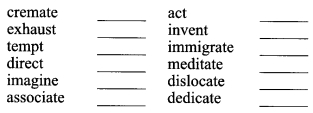
Answer:
Question 5.Now fill in the blanks with suitable words from the ones that you have formed.
- Mass literacy was possible only after the of the ……….. printing machine.
- Ramesh is unable to tackle the situation as he lacks ………..
- I could not resist the ……….. to open the letter.
- Hardwork and ……….. are the main keys to success.
- The children were almost fainting with ……….. after being made to stand in the sun.
Answer:
- invention
- imagination
- temptation
- dedication
- exhaustion.
CLASS-9 SUBJECT-HINDI CHAPTER-8 एक कुत्ता और एक मैना
EVENTS CONVENT HIGH SCHOOL
08/02/2022 CLASS- 9 SESSION 2021-22
SUBJECT : HINDI
CHAPTER-8
एक कुत्ता और एक मैना
______________________________________
1. निम्नलिखित वाक्यों में कर्म के आधार पर क्रिया-भेद बताइए-
(क) मीना कहानी सुनाती है।
(ख) अभिनव सो रहा है।
(ग) गाय घास खाती है।
(घ) मोहन ने भाई को गेंद दी।
(ङ) लड़कियाँ रोने लगीं।
उत्तर-
2.नीचे पाठ में से शब्द-युग्मों के कुछ उदाहरण दिए गए हैं; जैसे-
समय-असमय, अवस्था-अनवस्था
इन शब्दों में ‘अ’ उपसर्ग लगाकर नया शब्द बनाया गया है।
पाठ में से कुछ शब्द चुनिए और उनमें ‘अ’ एवं ‘अन्’ उपसर्ग लगाकर नए शब्द बनाइए।
उत्तर-
‘अ’ और ‘अन्’ उपसर्ग से बने शब्द-
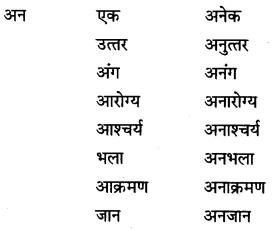
लघु उत्तरीय प्रश्न
प्रश्न 1.गुरुदेव को श्रीनिकेतन के पुराने आवास में ले जाने में परेशानी क्यों हो रही थी?
उत्तर-
गुरुदेव को श्रीनिकेतन के पुराने आवास में ले जाने में इसलिए परेशानी हो रही थी क्योंकि-
- गुरुदेव वृद्ध थे। उनका शरीर कमज़ोर हो चुका था।
- उन्होंने तीसरी मंजिल पर अपना आवास बनाने का निर्णय लिया था।
- लोहे की चक्करदार सीढ़ियों से उन्हें ले जाना आसान न था।
- गुरुदेव अपने आप चल-फिर नहीं सकते थे।
प्रश्न 2.गुरुदेव कैसे दर्शनार्थियों से डरते थे और क्यों ?
उत्तर-
गुरुदेव उन दर्शनार्थियों से डरते थे जो समय-असमय, स्थान आदि का ध्यान रखे बिना गुरुदेव से मिलने आ जाते थे और देर तक वह गुरुदेव से बातें किया करते थे। उनकी इस धृष्टता से गुरुदेव को कितनी परेशानी होती थी इसकी उन्हें चिंता नहीं रहती थी।
प्रश्न 3.गुरुदेव को शांतिनिकेतन की तुलना में श्रीनिकेतन किस तरह सुविधाजनक लगा?
उत्तर-
गुरुदेव को शांतिनिकेतन की अपेक्षा श्रीनिकेतन कई तरह से सुविधाजनक लगा; जैसे-
- श्रीनिकेतन का वातावरण अधिक शांतिमय था।
- श्रीनिकेतन में गुरुदेव से मिलने वालों की भीड़ नहीं होती थी।
- श्रीनिकेतन में वे अकेले रहते थे।
- यहाँ उन्हें अधिक सुखानुभूति होती थी।
प्रश्न 4.अचानक कुत्ते के आ जाने से गुरुदेव को कैसा लगा और क्यों?
उत्तर-
श्रीनिकेतन में अचानक कुत्ते के आ जाने से गुरुदेव को बड़ा आश्चर्य हुआ क्योंकि उसे श्रीनिकेतन के दो मील लंबे रास्ते का पता न था, न उसे किसी ने बताया था कि गुरुदेव यहाँ हैं। वह आत्मज्ञान से आया था।
प्रश्न 5.कुत्ता गुरुदेव के पास क्यों आ गया? गुरुदेव का सान्निध्य उसे कैसा लगता था?
उत्तर-
कुत्ता अत्यंत स्वामिभक्त था। वह गुरुदेव से असीम लगाव रखता था। वह गुरुदेव का प्यार भरा स्पर्श पाने के लिए उनके पास गया था। जब गुरुदेव ने कुत्ते की पीठ पर हाथ फेरा तो वह आँखें बंदकर रोम-रोम से स्नेह रस का अनुभव करने लगा। गुरुदेव के सान्निध्य की परितृप्ति उसके चेहरे पर झलकने लगी।
दीर्घ उत्तरीय प्रश्न
प्रश्न 1.गुरुदेव ने शांतिनिकेतन को छोड़ कहीं और रहने का मन क्यों बनाया?
उत्तर-
गुरुदेव अस्वस्थ थे। उन्हें एकांत और आराम की आवश्यकता थी। शांति निकेतन में दिन-भर आने-जाने वालों का ताँता लगा रहता था। इसलिए उन्होंने तय किया कि वे श्रीनिकेतन के अपने पुराने तिमंजले मकान में निवास करेंगे।
प्रश्न 2.मूक प्राणी मनुष्य से कम संवेदनशील नहीं होते। पाठ के आधार पर स्पष्ट कीजिए।
उत्तर-
‘एक कुत्ता और एक मैना’ निबंध में कुत्ते का संस्मरण पढ़ने से ज्ञात होता है कि मूक प्राणी भी बहुत संवेदनशील होते हैं। वह स्वामिभक्त कुत्ता गुरुदेव का सान्निध्य पाने के लिए दो मील का अनजान रास्ता तय करके गुरुदेव के पास श्री निकेतन आ गया और गुरुदेव का प्यार भर स्पर्श पाकर आनंदित हो उठा। इसी तरह गुरुदेव की मृत्यु पर वह चिताभस्म लाने वाले के साथ-साथ चलता हुआ उत्तरायण तक आया और चिताभस्म के पास बड़ी देर तक शांत भाव से बैठा रहा।
प्रश्न 3.गुरुदेव द्वारा मैना को लक्ष्य करके लिखी कविता के मर्म को लेखक कब समझ पाया?
उत्तर-
गुरुदेव द्वारा मैना को लक्ष्य करके लिखी गई कविता के मर्म को लेखक तब समझ पाया, जब उसने मैना के मुख के भावों पर ध्यान केंद्रित किया। उसके सामने मैना की करुण छवि साकार हो उठी। पहले उसने उसके करुण भावों पर ध्यान नहीं दिया था। परंतु कविता पढ़ने के बाद ध्यान दिया तो उसे कविता का मर्म भी समझ में आ गया।
Tuesday, February 1, 2022
CLASS-9 SUBJECT SCIENCE CHAPTER-8 MOTION
EVENTS CONVENT HIGH SCHOOL
01/02/2022 CLASS- 9 SESSION 2021-22
SUBJECT : SCIENCE
CHAPTER-8
MOTION
______________________________________
Very Short Answer Questions
Question 1.The phenomenon of motion was placed on a sound scientific footing by two scientists. Write their names.
Answer:
Galileo Galilei and Isaac Newton.
Question 2.Are rest and motion absolute or relative terms?
Answer:
They are relative terms.
Question 3.Suppose a ball is thrown vertically upwards from a position P above the ground. It rises to the highest point Q and returns to the same point P. What is the net displacement and distance travelled by the ball?
Answer:
Displacement is zero. Distance is twice the distance between position P and Q.
Question 4.Which speed is greater: 30 m/s or 30 km/h?
Answer:
30 m/s
Question 5.What do you mean by 2 m/s2?
Answer:
The velocity of the body increases by 2 m/s after every second.
Question 6.Can uniform linear motion be accelerated?
Answer:
No
Question 7.Define one radian.
Answer:
It is the angle which is subtended at the centre by an arc having a length equal to the radius of the circle.
Question 8.What is the relation between linear velocity and angular velocity?
Answer:
Linear velocity = Angular velocity × Radius of circular path.
Short Answer Type 1
Question 1.Distinguish between speed and velocity.
Answer:
Speed:
- Speed is the ratio of distance and time.
- Speed is always positive
- Speed is a scalar quantity.
Velocity:
- Velocity is the ratio of displacement and time.
- Velocity may be negative or positive.
- Velocity is a vector quantity.
Question 2.Distinguish between distance and displacement.
Answer:
Distance
- It is the actual length of the path covered by a moving body.
- It is always positive or zero.
- It is a scalar quantity.
Displacement:
- It is the shortest distance measured between the initial and final positions.
- It may be positive, negative, or zero.
- it is a vector quantity.
Question 3.Write down the SI unit of the following quantities:
(a) Displacement
(b) Speed
(c) Velocity
(d) Acceleration
Answer:
(a) m
(b) m/s
(c) m/s
(d) m/s2
DEFINE
Question 1.Define the following terms:
(a) Distance
(b) Displacement
(c) Speed
(d) Velocity
(e) Acceleration
(f) Uniform motion
(g) Uniform circular motion
(h) Scalar quantity
(i) Vector quantity
Answer:
(a) Distance: The total path length traveled by a body in a given interval of time is called distance.
(b) Displacement: The shortest distance measured from the initial to the final position of an object is known as displacement.
(c) Speed: The speed of a body is defined as the distance traveled per unit time.
(d) Velocity: Velocity is defined as displacement per unit time.
(e) Acceleration: The rate of change of velocity with respect to time.
(f) Uniform motion: A body moving in a straight line has a uniform motion if it travels the equal distance in equal intervals of tune.
(g) Non-uniform motion: A body has a non-uniform motion if it travels unequal distances in equal intervals of time.
(h) Scalar quantity: A physical quantity which is described completely by its magnitude only, is called a scalar quantity.
(i) Vector quantity: A physical quantity that has magnitude as well as direction and obeys the vector addition is called a vector quantity.
Question 2.Draw a position-time graph of for
(a) rest
(b) uniform motion
(c) Non-uniform motion
Answer:
(a) Position – time graph for rest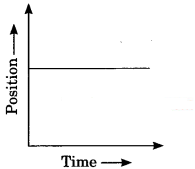
(b) Position – time graph for uniform motion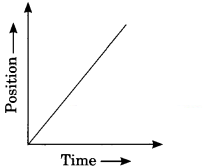
(c) Position – time graph for non-uniform motion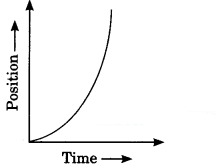
Monday, January 31, 2022
CLASS-9 SUBJECT MATHS CHAPTER-8 EXERCISE 8.1 QUADRILATERALS.
EVENTS CONVENT HIGH SCHOOL
31/01/2022 CLASS- 9 SESSION 2021-22
SUBJECT : MATHS
CHAPTER-8(eXERCISE 8.1)
QUADRILATERALS
______________________________________
Question 1.The angles of quadrilateral are in the ratio 3 : 5 : 9 : 13. Find all the angles of the quadrilateral.
Solution:
Let the angles of the quadrilateral be 3x, 5x, 9x and 13x.
∴ 3x + 5x + 9x + 13x = 360°
[Angle sum property of a quadrilateral]
⇒ 30x = 360°
⇒ x =
∴ 3x = 3 x 12° = 36°
5x = 5 x 12° = 60°
9x = 9 x 12° = 108°
13a = 13 x 12° = 156°
⇒ The required angles of the quadrilateral are 36°, 60°, 108° and 156°.
Question 2.If the diagonals of a parallelogram are equal, then show that it is a rectangle.
Solution:
Let ABCD is a parallelogram such that AC = BD.
In ∆ABC and ∆DCB,
AC = DB [Given]
AB = DC [Opposite sides of a parallelogram]
BC = CB [Common]
∴ ∆ABC ≅ ∆DCB [By SSS congruency]
⇒ ∠ABC = ∠DCB [By C.P.C.T.] …(1)
Now, AB || DC and BC is a transversal. [ ∵ ABCD is a parallelogram]
∴ ∠ABC + ∠DCB = 180° … (2) [Co-interior angles]
From (1) and (2), we have
∠ABC = ∠DCB = 90°
i.e., ABCD is a parallelogram having an angle equal to 90°.
∴ ABCD is a rectangle.
Question 3.Show that if the diagonals of a quadrilateral bisect each other at right angles, then it is a rhombus.
Solution:
Let ABCD be a quadrilateral such that the diagonals AC and BD bisect each other at right angles at O.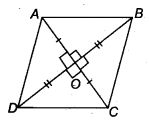
∴ In ∆AOB and ∆AOD, we have
AO = AO [Common]
OB = OD [O is the mid-point of BD]
∠AOB = ∠AOD [Each 90]
∴ ∆AQB ≅ ∆AOD [By,SAS congruency
∴ AB = AD [By C.P.C.T.] ……..(1)
Similarly, AB = BC .. .(2)
BC = CD …..(3)
CD = DA ……(4)
∴ From (1), (2), (3) and (4), we have
AB = BC = CD = DA
Thus, the quadrilateral ABCD is a rhombus.
Alternatively : ABCD can be proved first a parallelogram then proving one pair of adjacent sides equal will result in rhombus.
Question 4.Show that the diagonals of a square are equal and bisect each other at right angles.
Solution:
Let ABCD be a square such that its diagonals AC and BD intersect at O.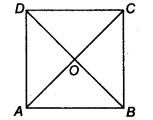
(i) To prove that the diagonals are equal, we need to prove AC = BD.
In ∆ABC and ∆BAD, we have
AB = BA [Common]
BC = AD [Sides of a square ABCD]
∠ABC = ∠BAD [Each angle is 90°]
∴ ∆ABC ≅ ∆BAD [By SAS congruency]
AC = BD [By C.P.C.T.] …(1)
(ii) AD || BC and AC is a transversal. [∵ A square is a parallelogram]
∴ ∠1 = ∠3
[Alternate interior angles are equal]
Similarly, ∠2 = ∠4
Now, in ∆OAD and ∆OCB, we have
AD = CB [Sides of a square ABCD]
∠1 = ∠3 [Proved]
∠2 = ∠4 [Proved]
∴ ∆OAD ≅ ∆OCB [By ASA congruency]
⇒ OA = OC and OD = OB [By C.P.C.T.]
i.e., the diagonals AC and BD bisect each other at O. …….(2)
(iii) In ∆OBA and ∆ODA, we have
OB = OD [Proved]
BA = DA [Sides of a square ABCD]
OA = OA [Common]
∴ ∆OBA ≅ ∆ODA [By SSS congruency]
⇒ ∠AOB = ∠AOD [By C.P.C.T.] …(3)
∵ ∠AOB and ∠AOD form a linear pair.
∴∠AOB + ∠AOD = 180°
∴∠AOB = ∠AOD = 90° [By(3)]
⇒ AC ⊥ BD …(4)
From (1), (2) and (4), we get AC and BD are equal and bisect each other at right angles.
Friday, January 28, 2022
CLASS-9 SUBJECT SOCIAL SCIENCE CHAPTER-5 NATURAL VEGITATION AND WILDLIFE
EVENTS CONVENT HIGH SCHOOL
27/01/2022 CLASS- 9 SESSION 2021-22
SUBJECT : SOCIAL SCIENCE
CHAPTER-5
NATURAL VEGITATION AND WILDLIFE
______________________________________
Very Short Answer Type Questions
Question 1.The number of flowering plants in India is about _______ .
Answer:
15,000
Question 2.Name two non-flowering plants.
Answer:
Algae, fungi and ferns.
Question 3.The sandy soils of desert support _______ .
Answer:
Cactus and thorny bushes.
Question 4.Sundari trees are found in _______ .
Answer:
Tidal Forests
Question 5.A very large ecosystem on land having distinct type of vegetation and animal life is called _______ .
Answer:
Biome
Question 6.At higher altitudes, mosses and lichens form part of _______ .
Answer:
Tundra vegetation
Question 7.The dry deciduous forests are found in areas having rainfall between _______ .
Answer:
100 cm and 70 cm
Question 8.The mangrove tidal forests are found in the areas of coasts influenced by sea _______ .
Answer:
Tides
Question 9.Royal Bengal Tiger is found in _______ .
Answer:
Mangrove forests
Question 10.Wildlife Protection Act was implemented in India in _______ .
Answer:
1972
Short Answer Type Questions
Question 1.How do human beings influence the ecology of a region?
Answer:
Human beings influence the ecology of a region in the following ways :
- They utilise the vegetation and wildlife of a particular region.
- The greed of human beings leads to overutilisation of these resources.
- They cut trees and kill the animals, thereby, creating an ecological imbalance.
Question 2.What are endangered species? Give examples.
Answer:
- The plants and animals that are at the verge of extinction are called endangered species.
- Rhinoceroes, Great Indians bustards and tigers are some of the examples of endangered species of animals.
Question 3.Write a short note on the biodiversity in India.
Or
‘India is one of the 12 mega biodiversity countries of the world’. Explain
Answer:Our country India is one of the 12 mega bio-diversity countries of the worid. With about 47,000 plant species, India occupies tenth place in the world and fourth in Asia in plant diversity.
- There are about 15,000 flowering plants in India, which account for 6 per cent in the world’s total number of flowering plants.
- The country has many non-flowering plants, such as ferns,’algae and fungi. India also has 90,000 species of animals, as well as, a rich variety of fish in its fresh and marine waters.
Question 4.Discuss how flora and fauna are interrelated to each other.
Answer:
The interrelation between flora and fauna is as under :
- Flora refers to the autotrophs, i.e., producer of their own food themselves, while fauna refers to the heterotrophs, i.e., getting their food directly or indirectly from autotrophs.
- Food webs and food chains make ex-facie the interrelation between the flora and fauna.
- Flora provides food to all living organisms while fauna provides nutrients to the soil from its waste and decay.
Long Answer Type Questions
Question 1 Distinguish between the moist and dry deciduous forests.
Answer:
| Moist Deciduous Forests | Dry Deciduous Forests |
| 1. These are found in areas receiving annual rainfall between 100 cm and 200 cm. | 1. These forests are found in areas receiving annual rainfall between 70 cm and 100 cm. |
| 2. Trees found in these forests are teak, sal, shisham, sandalwood, khair and bamboos. | 2. There are open stretches in which, teak, sal, peepal, neem, etc. grow. |
| 3. These forests are generally found in Jharkhand, West Odisha, Chhattisgarh and on the eastern slopes of the Western Ghats. | 3. These forests are found in the rainer parts of the peninsular plateau and the plains of U.R, and Bihar. |
Question 2 Write a short note on thorny forests and scrubs.
Answer:
The thorny forest and scrubs are found in regions with less than 70 cm of rainfall, the natural vegetation consists of thorny trees and bushes. This type of vegetation is found in the north-western part of the country, including semi-arid areas of Gujarat, Rajasthan, Madhya Pradesh, Chhattisgarh, Uttar Pradesh and Haryana. Acacias, palms, euphorbias and cacti are the main plant species. Trees are scattered and have long roots penetrating deep into the soil to get moisture. The stems are succulent to conserve water. Leaves are mostly thick and small to minimise evaporation. These forests give way to thorn forests and scrubs in arid areas. In these forests, the common animals are rats, mice, rabbits, fox, wolf, tiger, lion, wild ass, horses and camels.
Question .3 Write three measures to conserve ecosystem.
Answer:
The measures to conserve ecosystem are :
- Deforestation has disturbed our ecosystem. It must be stopped forthwith.
- Indiscriminate killing of wild animals has distorted our ecosystem. Hence, killing of
animals should be stopped immediately. - Ecosystem can be conserved by developing more wildlife sanctuaries, national parks and biosphere reserves.
Question. 4Why is conservation of wildlife very essential? Explain.
Answer:
The government has taken many special efforts to preserve endangered species of birds and animals. Periodic census is undertaken to find out the latest position and trends in this regard. The Project Tiger has been a great success. We have many tiger reserves in various parts of the country. Likewise, the Project Rhino is being implemented in Assam. The Indian Bustard of Rajasthan and Malwa Plateau are yet another endangered species. Even the number of lions had been dwindling for long. Conservation of wildlife is essential in order to protect the endangered species of birds and animals and also to maintain the ecological balance. The Government of India has so far set-up eighteen biosphere reserves.

